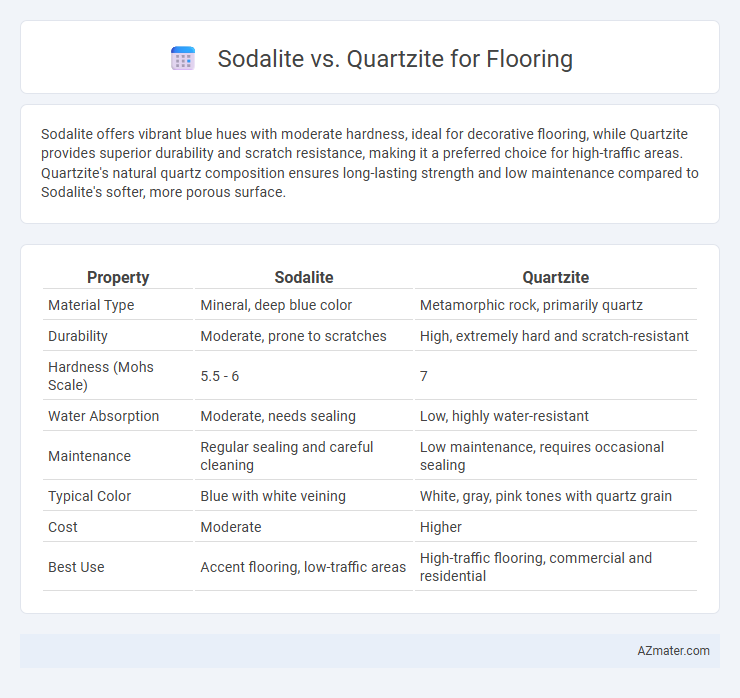Sodalite offers vibrant blue hues with moderate hardness, ideal for decorative flooring, while Quartzite provides superior durability and scratch resistance, making it a preferred choice for high-traffic areas. Quartzite's natural quartz composition ensures long-lasting strength and low maintenance compared to Sodalite's softer, more porous surface.
Table of Comparison
| Property | Sodalite | Quartzite |
|---|---|---|
| Material Type | Mineral, deep blue color | Metamorphic rock, primarily quartz |
| Durability | Moderate, prone to scratches | High, extremely hard and scratch-resistant |
| Hardness (Mohs Scale) | 5.5 - 6 | 7 |
| Water Absorption | Moderate, needs sealing | Low, highly water-resistant |
| Maintenance | Regular sealing and careful cleaning | Low maintenance, requires occasional sealing |
| Typical Color | Blue with white veining | White, gray, pink tones with quartz grain |
| Cost | Moderate | Higher |
| Best Use | Accent flooring, low-traffic areas | High-traffic flooring, commercial and residential |
Introduction to Sodalite and Quartzite Flooring
Sodalite flooring offers vibrant blue hues with white veining, creating a striking and unique aesthetic ideal for bold interior designs. Quartzite flooring provides exceptional hardness and durability, featuring a natural stone appearance with subtle color variations ranging from white to gray and pink. Both materials are highly resistant to wear, but quartzite's superior strength makes it more suitable for high-traffic areas.
Composition and Geological Differences
Sodalite is a tectosilicate mineral primarily composed of sodium aluminum silicate with chlorine, characterized by its rich blue color and crystal structure formed in igneous rocks. Quartzite, a metamorphic rock originating from sandstone, consists predominantly of quartz (silicon dioxide) grains fused under high temperature and pressure, yielding exceptional hardness and durability ideal for flooring. The key geological difference lies in Sodalite's crystallization in silica-poor environments versus Quartzite's transformation through regional metamorphism of quartz-rich sandstone, impacting their physical properties and suitability for different flooring applications.
Visual Appeal: Color and Pattern Variations
Sodalite flooring offers deep blue tones with white veining, creating a bold and dramatic visual impact, while quartzite presents a broader color spectrum ranging from whites and grays to subtle pinks and greens, often featuring intricate, natural patterns. The unique crystalline structure of quartzite provides a more textured appearance that enhances its natural stone authenticity, contrasting with the smoother, glassy look of sodalite. Both materials bring distinct aesthetic benefits, with sodalite favoring striking color uniformity and quartzite excelling in complex, organic pattern variations.
Durability and Hardness Comparison
Sodalite offers moderate hardness with a Mohs rating of around 5.5 to 6, making it less resistant to scratches and wear compared to quartzite, which scores between 7 and 8 on the Mohs scale. Quartzite's high durability and resistance to abrasion make it an ideal choice for high-traffic flooring areas, maintaining its appearance over time without significant damage. Sodalite flooring is more suitable for areas with low foot traffic or decorative purposes due to its comparatively softer nature and lower resilience.
Water Resistance and Stain Protection
Sodalite offers moderate water resistance but requires sealing to enhance stain protection, making it suitable for low-moisture areas in flooring applications. Quartzite exhibits superior water resistance and natural stain protection due to its dense, non-porous structure, rendering it ideal for high-traffic and moisture-prone floors. Proper sealing of both stones extends durability, with quartzite demanding less frequent maintenance compared to sodalite.
Maintenance Requirements and Ease of Cleaning
Sodalite flooring requires regular sealing to prevent staining and maintain its vibrant blue color, while quartzite is naturally more resistant to stains and scratches, demanding less intensive upkeep. Both stones are best cleaned with pH-neutral cleaners, but quartzite's harder surface allows for easier removal of dirt and debris without risk of etching. Routine sweeping and occasional damp mopping suffice for quartzite, whereas sodalite may need more frequent attention to preserve its aesthetic integrity.
Cost and Value Considerations
Sodalite flooring typically costs more than quartzite due to its rarity and striking blue hues, making it a premium choice for luxury interiors. Quartzite offers better value with its durability, resistance to scratches, and generally lower price point, suitable for high-traffic areas. While sodalite provides unique aesthetic appeal that can increase property value, quartzite's longevity and cost-effectiveness make it a practical investment for long-term flooring needs.
Installation Process and Challenges
Sodalite flooring requires careful sealing and polishing due to its porous nature, making installation more labor-intensive compared to the dense and durable quartzite, which demands specialized cutting tools to handle its hardness. Quartzite's resistance to abrasions ensures longevity but poses challenges during precise cutting and fitting, whereas sodalite's softer texture is easier to shape but more prone to chipping. Both materials necessitate experienced installers, with quartzite installations typically taking longer due to its toughness and requiring a moisture barrier to prevent damage.
Best Use Cases for Sodalite vs Quartzite Flooring
Sodalite flooring excels in spaces requiring vibrant blue hues and unique veining, making it ideal for accent areas, feature walls, and decorative flooring in residential or commercial interiors. Quartzite flooring offers exceptional durability and resistance to abrasion, suited for high-traffic areas such as kitchens, hallways, and outdoor patios where strength and longevity are critical. Both materials provide distinct aesthetics, with sodalite favored for bold color statements and quartzite preferred for its natural stone appearance and robustness in heavy-use environments.
Final Verdict: Choosing the Right Stone for Your Floor
Sodalite offers a unique deep blue hue and bold veining ideal for striking, decorative flooring but requires regular sealing due to its moderate hardness and porosity. Quartzite provides superior durability and resistance to scratches, stains, and heat, making it a practical choice for high-traffic areas and long-term value in flooring applications. The final verdict depends on whether aesthetic impact or durability and maintenance ease are your top priorities for a lasting floor installation.

Infographic: Sodalite vs Quartzite for Flooring
 azmater.com
azmater.com